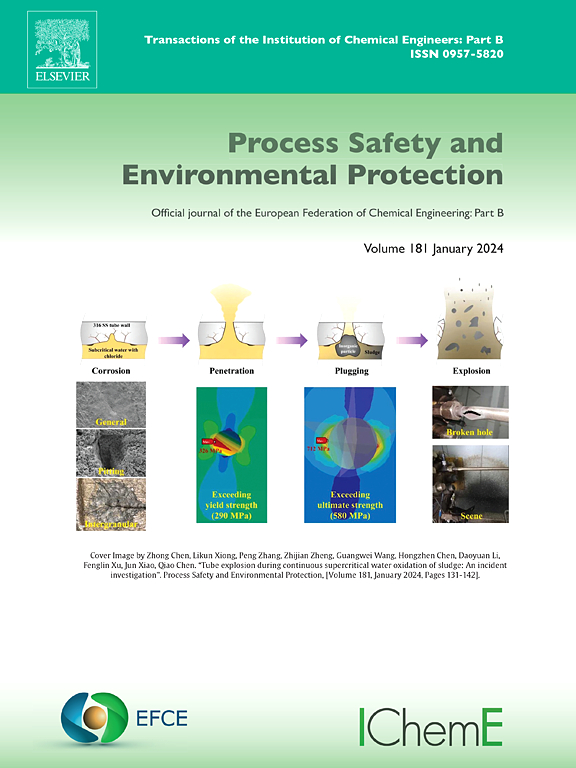Spatio-temporal interactive network: A knowledge-guided federated learning for fault propagation path identification
IF 6.9
2区 环境科学与生态学
Q1 ENGINEERING, CHEMICAL
引用次数: 0
Abstract
As a cutting-edge technology, federated learning (FL) demonstrates great potential in industrial fault propagation path identification, which uncovers the intrinsic relationships between variables by collaborating across multiple clients while preserving privacy, contributing to process safety and system optimization. However, existing FL methods do not take into account the interactive fusion of multi-scale features, resulting in insufficient feature mining and low utilization. In addition, purely data-driven FL naturally interpret the analyzed causality as propagation paths. In this paper, a knowledge-guided FL method with spatio-temporal interactive network is proposed for fault propagation path identification. First, we develop a knowledge-guided comprehensive graph construction module to provide the required adjacency matrix for subsequent model. After that, spatio-temporal soft attention prediction model is designed to mine spatio-temporal interactive information and the communication efficiency and model accuracy are further reconciled by residual-wise adaptive parameter aggregation scheme. Then, the causality is accurately characterized with the collaboration of mechanism knowledge and data, which makes the fault propagation path more explainable. Finally, in order to verify the effectiveness of the method, we carried out experiments on the simulation of Tennessee Eastman process and the real-world coal mill unit dataset.
时空交互网络:知识引导下的故障传播路径识别联合学习
作为一项前沿技术,联邦学习(FL)在工业故障传播路径识别中显示出巨大的潜力,它通过跨多个客户端协作揭示变量之间的内在关系,同时保护隐私,有助于过程安全和系统优化。然而,现有的FL方法没有考虑到多尺度特征的交互融合,导致特征挖掘不足,利用率低。此外,纯数据驱动的FL自然地将分析的因果关系解释为传播路径。本文提出了一种基于时空交互网络的知识引导故障传播路径识别方法。首先,我们开发了一个知识引导的综合图构建模块,为后续模型提供所需的邻接矩阵。然后,设计时空软注意力预测模型,挖掘时空交互信息,并采用残差自适应参数聚合方案进一步协调通信效率和模型精度。然后,通过机制知识和数据的协同,准确表征故障的因果关系,使故障传播路径更具可解释性。最后,为了验证该方法的有效性,我们在田纳西州伊士曼过程和实际煤机机组数据集上进行了仿真实验。
本文章由计算机程序翻译,如有差异,请以英文原文为准。
求助全文
约1分钟内获得全文
求助全文
来源期刊

Process Safety and Environmental Protection
环境科学-工程:化工
CiteScore
11.40
自引率
15.40%
发文量
929
审稿时长
8.0 months
期刊介绍:
The Process Safety and Environmental Protection (PSEP) journal is a leading international publication that focuses on the publication of high-quality, original research papers in the field of engineering, specifically those related to the safety of industrial processes and environmental protection. The journal encourages submissions that present new developments in safety and environmental aspects, particularly those that show how research findings can be applied in process engineering design and practice.
PSEP is particularly interested in research that brings fresh perspectives to established engineering principles, identifies unsolved problems, or suggests directions for future research. The journal also values contributions that push the boundaries of traditional engineering and welcomes multidisciplinary papers.
PSEP's articles are abstracted and indexed by a range of databases and services, which helps to ensure that the journal's research is accessible and recognized in the academic and professional communities. These databases include ANTE, Chemical Abstracts, Chemical Hazards in Industry, Current Contents, Elsevier Engineering Information database, Pascal Francis, Web of Science, Scopus, Engineering Information Database EnCompass LIT (Elsevier), and INSPEC. This wide coverage facilitates the dissemination of the journal's content to a global audience interested in process safety and environmental engineering.
 求助内容:
求助内容: 应助结果提醒方式:
应助结果提醒方式:


